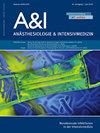Objektive Verlegungskriterien und proaktives Verlegungsmanagement zur Steuerung von intensivmedizinischen Kapazitäten
IF 0.5
4区 医学
Q4 ANESTHESIOLOGY
引用次数: 0
Abstract
Despite the high number of intensive care beds in German hospitals compared to other European countries, intensive care medical shortages are common in daily clinical practice. This is due to a hardly established cross-departmental discharge and transfer management with missing objective discharge criteria, lack of personnel and bed closures. Aboveaverage lengths of stays and increased readmission rates to the intensive care unit also indicate an inefficient use of resources in German hospitals. Against this background, a systematic literature search was carried out on the current state of research on discharge criteria from the intensive care unit and transfer processes to follow-up wards. Between 1983 and 2020, 1,917 sources were found, 286 were selected as full text, 104 of which were considered relevant and used as the basis for this work. Approaches, such as a root cause analy- sis of bottleneck situations including the entire hospital system with its interdependent admission, transfer and discharge processes, and the use of electronic decision support in conjunction with standardised discharge criteria can improve the use of existing intensive care capacities and lead to safer and better patient flow. For better use of resources, the therapeutic outcome must be viewed along the entire clinical pathway in order to care for the right patient at the right place and at the right time. A standardised care transition management using objective discharge criteria could help to include the various stakeholders in the discharge decision and patient-transfer process to reflect patient-, caregiver-, process, and institution-specific factors, and ultimately to manage, proactively and efficiently, the available intensive care resources. Decision support in the discharge process using self-learning systems based on available data from patient data management systems is forward-looking, but must be validated more widely in clinical practice.合理部署标准和主动部署管理来控制高精卫医疗能力
尽管与其他欧洲国家相比,德国医院的重症监护病床数量较多,但重症监护医疗短缺在日常临床实践中很常见。这是由于几乎没有建立跨部门的出院和转院管理,缺乏客观的出院标准,缺乏人员和床位关闭。住院时间超过平均水平,重症监护室再入院率增加,也表明德国医院资源利用效率低下。在此背景下,我们对重症监护病房的出院标准和转院流程的研究现状进行了系统的文献检索。1983年至2020年共发现文献1917份,选取全文286份,其中认为相关文献104份作为本工作的基础。诸如瓶颈情况的根本原因分析,包括整个医院系统及其相互依赖的入院、转院和出院流程,以及结合标准化出院标准使用电子决策支持等方法,可以改善现有重症监护能力的使用,并导致更安全和更好的患者流动。为了更好地利用资源,必须沿着整个临床路径来观察治疗结果,以便在正确的地点和正确的时间照顾正确的病人。使用客观出院标准的标准化护理过渡管理可以帮助包括出院决策和患者转移过程中的各种利益相关者,以反映患者,护理人员,过程和机构特定因素,并最终积极有效地管理可用的重症监护资源。在出院过程中使用基于患者数据管理系统中可用数据的自我学习系统的决策支持具有前瞻性,但必须在临床实践中得到更广泛的验证。
本文章由计算机程序翻译,如有差异,请以英文原文为准。
求助全文
约1分钟内获得全文
求助全文
来源期刊
CiteScore
0.90
自引率
14.30%
发文量
0
审稿时长
>12 weeks
期刊介绍:
Die „Anästhesiologie & Intensivmedizin“ (A&I) ist mit einer Auflage von rund 27.000 Exemplaren (IVW-geprüft) die auflagenstärkste Fachzeitschrift im deutschen AINS-Markt.
Die A&I informiert die in diesem Fachgebiet tätige ärztliche Berufsgruppe monatlich (mit Ausnahme einer, im August erscheinenden Doppelausgabe Juli/August) über aktuelle Entwicklungen in der Anästhesiologie mit ihren vier Säulen – Anästhesie, Intensivmedizin, Notfallmedizin und Schmerztherapie und wendet sich an Anästhesistinnen und Anästhesisten in Klinik, Praxis und Forschung.
Die A&I ist offizielles Organ der anästhesiologischen Verbände in Deutschland und damit unter anderem „Pflichtlektüre“ für Führungskräfte und Entscheidungsträger in anästhesiologischen Krankenhausabteilungen und Praxen.

 求助内容:
求助内容: 应助结果提醒方式:
应助结果提醒方式:


